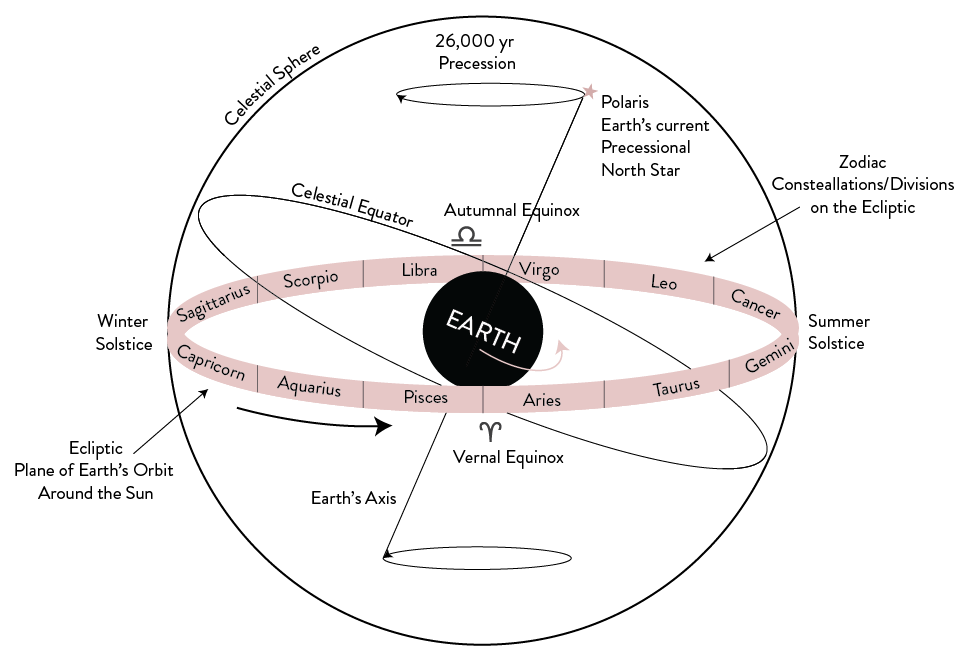The Zodiac
noun
a belt of the heavens within about 8° either side of the ecliptic, including all apparent positions of the sun, moon, and most familiar planets. It is divided into twelve equal divisions or signs (Aries, Taurus, Gemini, Cancer, Leo, Virgo, Libra, Scorpio, Sagittarius, Capricorn, Aquarius, Pisces).
- Oxford Languages
the ecliptic & the equator
The Ecliptic
When we look at the night sky, stars and constellations fill up the whole of our view of space. Similarly, in the daytime, we have skies that stretch out from beyond one horizon to beyond the opposite horizon. The ecliptic is a strip of our view of space that follows the apparent path of our Sun and holds specific stars and constellations. This belt of space includes 8° of space above and below its center.
The Equator
The equator is the center line between Earth’s poles, dividing its top and bottom halves (Northern and Southern Hemispheres). If Earth’s axis were exactly perpendicular to its plane of orbit around the Sun, our celestial equator (the equator projected out into space) would share the same space as the ecliptic. Because of the 23.5° tilt of Earth’s axis, relative to the ecliptic, we experience seasons and see a shifting view of the ecliptic throughout the year. We perceive the Sun as more north or south in our skies during different seasons due to the interaction of our equator and our plane of orbit around the Sun (the ecliptic).
precession
In addition to our tilt relative to our orbital plane, our axis also has a very slow yet predictable wobble. If you were to draw a line into space from our poles, these lines also make a little circle in space over 26,000 years. This shifts the fixed stars we see at certain times of the year. Throughout one human lifetime, it is hardly noticeable as it takes about 72 years to shift our view of space by one degree around the ecliptic. This process is called precession. In our current orientation, the line of the north pole points toward the star Polaris, which is why we consider this star our North Star.
Precession is the measurement used to decide which ‘age’ we are in, with an age lasting 2,150 years. I’m sure you’ve heard the term ‘Age of Aquarius’. Ages are determined by the constellation that the Sun points toward on Spring Equinox, using the Sidereal Zodiac. I love to think of the Sidereal Zodiac as more cosmic-oriented versus the Tropical Zodiac orienting us through the Earth’s rhythms, both beautiful in their own right. Many astrologers say we’ve entered the Age of Aquarius, but I hold that we are still in the Age of Pisces. Due to the wobble of the Earth causing a backward precession of our poles and how one might calculate the Sidereal Zodiac, there is some disagreement as to when the ‘Age of Aquarius’ started or will start. Many look at the themes present in society for signs and greater influences.
One reason many believe we have entered the Age of Aquarius is the rapid development of technology, an Aquarian theme. But, this can be explained by another large-scale transit pattern between Saturn and Jupiter. These two planets, ruling society and culture set the tone for how we develop at sociocultural levels. They will meet up every 20 years in the zodiac in signs of the same element, for about 200 years. As they end out one element and prepare for the next, they will jump back and forth.
In 1980 these two started their air sign initiative, which brought new forms of thinking and technology around intelligence. For the previous 200 years they had been meeting up in Earth signs, hence the Industrial Revolution. In 2000, these two planets jumped back and met in Earth again, bridging growing intellectual insight to how we had gained beautiful insights through empiricism and how we had been destructive with Earth or overly reliant on what is tangible in how we understand life. In 2020, these two finally moved on for good (or for the next 180 years) to meeting in Air signs, this last meeting taking place in Aquarius—thinking of the future, humanity, revolution, and shaking things up to be and do better through collaboration and transparency (decentralizing for more creative and free collaboration).
Some interpret the signs as the Age we’ve moved into, but I believe the Jupiter-Saturn link is what is going on (with a couple of smaller transits as well). What makes me think we are still in the Age of Pisces is we are still living out the program of spiritual religions, introduced through Christianity, Islam, and Buddhism all rose to influence over the past 2,000 years. The world is still living a program of religious wars, ideology, and control, along with spiritual questing, whether through organized religion or less prescriptive avenues. We also seem, still, to be living out the program of the Roman Empire and conquest, spreading our influence in the world in ways that have blurred lines and boundaries, a Pisce theme of dissolving boundaries and blurring our sense of Self. For further exploration of this thread, I go into greater depth in A Dance Through the Stars.
Sidereal zodiac (Eastern astrology)
The zodiac is a way of dividing up the ecliptic, which is of central importance to astrology. Most Eastern astrology systems divide the zodiac based on the constellations that inhabit the ecliptic. This division is called the Sidereal Zodiac. Because of precession, this system of dividing the zodiac changes over time. For example, a birthday of August 1st 2,000 years ago meant you were born with your Sun in Leo, but today it would make you a Cancer Sun sign (as precession moves backward around the zodiac).
The astrological qualities given to a sign lie with the fixed stars in the Sidereal system of astrology.
tropical zodiac (western astrology)
The zodiac that Western astrology uses, and likely the astrology you are familiar with, is the Tropical Zodiac. This way of devising the zodiac is based on solstices and equinoxes. The exact moment of the Spring Equinox marks the first degree of this zodiac, 0° of Aries, despite where any fixed stars are. The zodiac is then divided into 12 equal parts of 30° each.
In the Tropical Zodiac, it wouldn’t matter if you were born 5,000 years ago just after Autumn Equinox or last year just after Autumn Equinox, you would be born under a Libra Sun. This system is seasonal, based on the interaction between our equator and the ecliptic. I adore the dance with Earth that this zodiac includes.
ZodiacAL SeasonS
Because I use the Tropical Zodiac, I view astrology as somewhat of a seasonal system. The part of the zodiac that the Sun is pulling us toward marks the general zodiacal season, or solar season, we are experiencing. I also use Earth Signs, so at night as we turn away from the Sun, we see the opposite part of the zodiac in our night sky, showing how we are grounding, dreaming, and restoring.
I love to experiment with flipping the zodiac in the Southern Hemisphere. It brings an elegant balance when playing with the polarity inherent in our zodiac, with each sign having a polar sign that plays with the same themes but in opposite ways (Leo is personal creativity and Aquarius is collective creativity). I explore this viewpoint more deeply in A Dance Through the Stars, a portal on this website.
BOTH ZODIACS
While I base my astrology charts on the Tropical Zodiac, I’m not dismissive of the Sidereal Zodiac. I can’t claim to be an expert (by any stretch of the imagination) in Eastern astrology, but I have dabbled with using fixed stars said to hold specific qualities and influences. For example, Regulus, a star that currently sits in the first degree of Virgo in the Tropical Zodiac and is the brightest star in the Leo constellation (actually a triple star), is said to bring honors and victories. I have found this to be accurate when applied to charts.
"We need not feel ashamed of flirting with the zodiac. The zodiac is well worth flirting with."
- D. H. Lawrence




